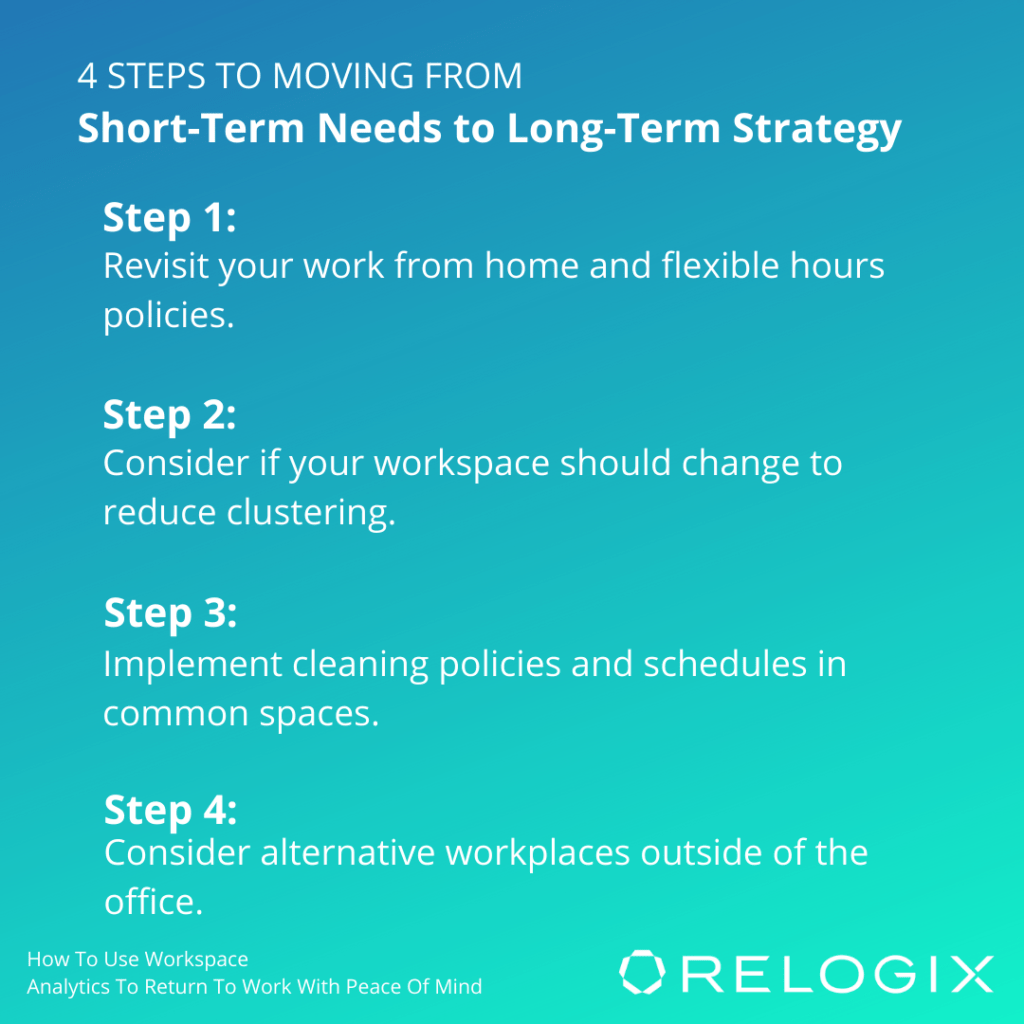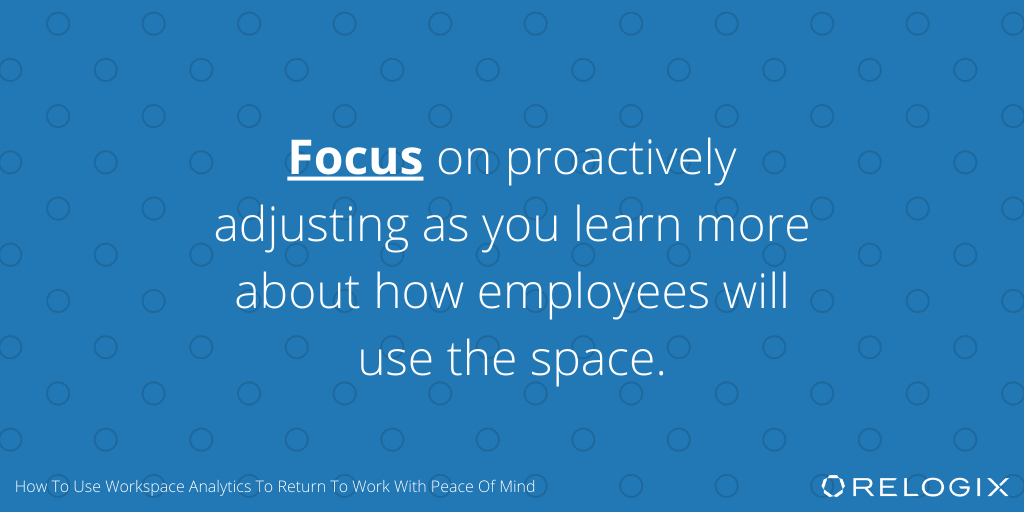How To Use Workspace Analytics To Return To Work With Peace Of Mind
The sudden and widespread shift to working from home as a response to COVID-19 has disrupted the traditional workplace like never before. Pre-COVID-19 many companies held hard stances, for various reasons, against work from home and flex work, but all of those objections and rationalizations quickly evaporated as organizations were forced to find ways to make it work – or suffer the consequences.
This new normal will inevitably influence the future of workplaces and office spaces in lasting and meaningful ways, and as business leaders we need to start preparing for what the workplace experience will become. Before we can start the conversation about bringing anyone back into the office, we need to take a closer look at the emerging health and safety implications in the workplace, including addressing comfort and security, which are necessary for rebuilding employee confidence in a post-COVID-19 world.
Knowing what data is available and how it can help you align with emerging best practices on how to effectively manage your office space will be key to an effective and informed return to work strategy.
Employees, understandably, will be nervous about returning to work, whether they have assigned or unassigned workspaces. Regardless of industry or location, the onus will be on employers around the world to ensure return to work is conducted safely.
Luckily, many of the metrics traditionally used to measure and evaluate the efficient use of your workspace can also be used here. Observing key metrics like occupancy, space utilization, dwell times, and seat sharing ratios through a health and safety lens, quickly reveals the necessary insights to support responsible return to work plans.
Communication will be key as you develop your plans, policies and new measures for returning to work. Letting your workforce know that you will be using this data to help keep them safe, healthy, and productive is step one. Let them know you will be collecting real-time data to help monitor compliance with safety measures and identify risk, so everyone stays safe and healthy.
Communicate early and often; look at this time as an opportunity to build trust with employees and open a dialogue about how this data will be used moving forward.
Before you start looking at your workspace data, revisit your work from home and flexible hours policies. Any changes here may dramatically impact how your workspace is used moving forward, and employee expectations have likely changed since you originally drafted those policies. Organizations may meet extreme resistance if they try to fall back to previous, restrictive policies, now that team members have had the opportunity to work from home or have been required to work flexibly – even if it wasn’t by choice.

Once you have updated your policies on how and when employees are expected to be at the office, you can start looking at how you can better (and safely) use that office space while being mindful of social distancing best practices and the risks of shared surfaces.
Next, consider if your workspace and collaboration seating and desk layouts should change at all. Once you start moving back into the office, leverage data on occupancy, density, and desk utilization in the short-term to actively adjust and manage logistics.
With the recent trends toward open offices and agile workspaces, organizations need to be attentive to keeping density low, adjusting workstation size or availability, and actively prioritizing cleaning routines. Desk utilization data can be used to inform employees where ‘safe seats’ are located and to inform cleaning teams on areas to focus on for disinfection. If you don’t have a cleaning policy or schedule in place to ensure shared or common spaces are disinfected regularly before returning to work, now is the time to implement one. As you return to work, update your schedule and policy as you collect more data and learn more precisely how the space is being used.
While the short-term focus will be dominated by decisions around health, safety, and compliance, the unprecedented move to include work from home as an alternative and acceptable work setting will change the long-term expectations of traditional office workspaces. Data collection on changing behaviours throughout the return to work phase will provide insights to help inform an effective long-term strategy. A shift to include alternative workplaces outside of the office can have significant implications for office space and workspace design requirements.

A successful long-term transition back to work should focus on proactively adjusting office space utilization as you learn more about how employees will use the space going forward.
Flexibility will be key as you go through the next adjustment phase. Allow your organization time to settle into the new normal and to establish new behaviours and routines. The first little while may be a bit chaotic, but we do anticipate many employees will push to work from home at least some of the time and may even push for more flexible work schedules overall.
As expectations around what the office represents to employees shifts, the allocation and defined use of space will need to account for a new normal. Insights and trends that you may have incorporated throughout your workplace strategy before the pandemic may no longer be priorities, or event relevant. This might mean potential changes to seating allocations in the office, for example, which in some instances may lead to significant square foot and cost reductions, which can help to off-set other costs.
Changes to expectations and behaviours mean you need to be prepared for several phases of change before you settle into a long-term workplace design and set up.
Even while reviewing the mechanics of returning to work through a post-pandemic lens, it’s important to remember your long-term organizational needs. You don’t want to have to overhaul your workspace multiple times or have to revisit any new policies that are implemented, so be sure to consider the new normal that will take effect immediately as well as in the future.
Remember that although we’ve seen unprecedented change and upheaval in the last few months, employees are generally pretty resistant to change, and they’ll be looking to assert and regain some control as things return to business as usual. Expect resistance and challenges from your team and use your data to help back up your decisions.
Communicate that data and your reasons for your decisions to provide context, make sure the “why” is clear for every policy, desk, space, and schedule change. An example might be:
“With more employees working from home or on flexible schedules, we now have an average occupancy rate of 42%, meaning only 42% of our desks are being used at any given time. We are leveraging the reduction in desk use to help maintain physical distancing and are using data to manage the 6-foot space between each seating area ask that for training, coaching, and collaborative work you use a boardroom instead of pulling chairs into a single workspace and continue to maintain distance.
Each boardroom has been stocked with hand sanitizer, facial tissue, and disinfectant wipes for your use after touching door handles and before touching shared tables and chairs. Please notify the facility manager if any of these supplies run low.
Additionally, we have observed that the kitchen at peak times (lunchtime) is very busy. With the size of the kitchen, it is impossible to maintain a safe 6-foot distance with that many employees, so we are requesting individuals, teams, and managers proactively shift and stagger their regular lunch times.
If we do not see a decrease in concentration in the kitchen, we may have to consider more strict policies around breaks and lunches. Our ideal goal is no more than eight employees in the kitchen at any one time, which would allow safe physical distancing as needed.”
Your employees will value transparency and candidness in handling their health and safety. By harnessing your workplace data, paired with medically informed best practices, your decisions will have positive outcomes in employee wellness, satisfaction, and security as you navigate the future of work.
Behavioural changes related to when and where employees work will likely mean less daily dependency on office space. The meaning and purpose of the office will be redefined in the next while, and there will also be significant cost savings opportunities driven by the changes we are all about to experience.
As workplace efficiency and optimization strategies pick up momentum, consider the enablers and the inhibitors to employee engagement and productivity, so you can re-invest some of the savings into programs, technology tools, and infrastructure to allow your business and employees to thrive.
To learn more about how you can effectively plan for the return to work, sign up to attend a webinar hosted by Relogix, Ask-Me-Anything: What Will The Workplace Be Like After COVID-19. You can get more details on managing your portfolio during the COVID-19 crisis here.

